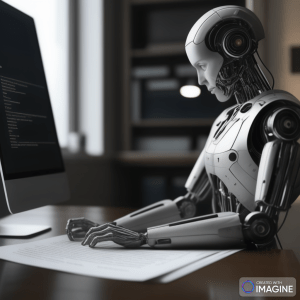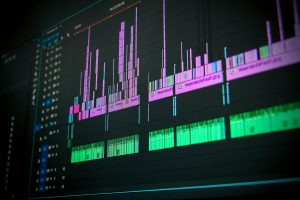Our company motto is ‘Capture the Human Experience.’ We firmly believe in the power of nonfiction filmmaking about people. Real people. That will never change and no amount of technological advancement will change that for us. However, artificial Intelligence (AI) is already making a significant impact on the filmmaking industry, and its influence is likely to grow in various ways. Whether it’s with pre-production, production, or post-production, AI is a great help for certain cold, automatable tasks that leave space for MORE creative, human tasks. Here are some ways AI can assist with filmmaking:
1. Content Creation:
 AI algorithms can analyze data and utilize this to identify popular trends and audience preferences. These tools can generate story ideas, scripts, and even assist in creating fictional dialogues based on patterns and sentiment analysis. AI also enables the creation of personalized content tailored to individual viewer preferences. There are multiple ways Artificial Intelligence can help with content creation. Through AI-powered Natural Language Generation (NLG) algorithms can help to create written content including articles, blog posts, and reports. These systems analyze data, understand context, and generate coherent and contextually relevant text. With AI, automated video production is made possible. It is able to automatically generate videos by combining pre-existing footage, images, and text.
AI algorithms can analyze data and utilize this to identify popular trends and audience preferences. These tools can generate story ideas, scripts, and even assist in creating fictional dialogues based on patterns and sentiment analysis. AI also enables the creation of personalized content tailored to individual viewer preferences. There are multiple ways Artificial Intelligence can help with content creation. Through AI-powered Natural Language Generation (NLG) algorithms can help to create written content including articles, blog posts, and reports. These systems analyze data, understand context, and generate coherent and contextually relevant text. With AI, automated video production is made possible. It is able to automatically generate videos by combining pre-existing footage, images, and text.
This is especially useful for creating marketing content like promotional videos and product demonstrations. OpenArt is a creative and versatile tool that is great for content creation. With this platform, you can bring your ideas to life by animating your images, converting images to a text prompt, and drawing your thoughts. This is great for getting a creative boost.
2. Scriptwriting Assistance:
 Artificial Intelligence can provide valuable assistance to screenwriters by offering creative insights, generating content, and streamlining various aspects of the screenwriting process. AI can aid screenwriters by suggesting plot twists, character developments, and dialogue options. And, Natural Language Processing (NLP) allows AI to understand and respond to creative input, making the scriptwriting process more collaborative. AI is also able to help with writing dialogue. With NLP algorithms, AI can generate realistic and engaging dialogue. This feature can also refine character voices, maintain consistent tone, and enhance overall quality of the script.
Artificial Intelligence can provide valuable assistance to screenwriters by offering creative insights, generating content, and streamlining various aspects of the screenwriting process. AI can aid screenwriters by suggesting plot twists, character developments, and dialogue options. And, Natural Language Processing (NLP) allows AI to understand and respond to creative input, making the scriptwriting process more collaborative. AI is also able to help with writing dialogue. With NLP algorithms, AI can generate realistic and engaging dialogue. This feature can also refine character voices, maintain consistent tone, and enhance overall quality of the script.
ChatGPT is an excellent resource for helping with written content and research. We are 100% against copy and pasting for any type of creative writing in which a person is taking credit. But we do believe that it can be used to break out of writing blocks or getting the juices flowing. One way to think about it is an assistant. It is there to get you information but it is up to you to write it in your own voice and make it yours.
3. Pre-Production Planning:
 AI helps in planning various aspects of pre-production, such as location scouting and set design. It can analyze historical data, weather patterns, and other factors to optimize the shooting schedule. The features that assist with scheduling can also optimize resource allocation, production timelines, and helping to create a realistic budget. And, with facial recognition technology, AI can assist in finding actors with desired physical attributes and suggest them based on their suitability for specific roles. Another useful element is virtual production planning. AI can contribute to the planning of virtual productions, helping to create realistic virtual environments. It can simulate lighting conditions, camera angles, and other factors to ensure a seamless integration of live-action and virtual elements.
AI helps in planning various aspects of pre-production, such as location scouting and set design. It can analyze historical data, weather patterns, and other factors to optimize the shooting schedule. The features that assist with scheduling can also optimize resource allocation, production timelines, and helping to create a realistic budget. And, with facial recognition technology, AI can assist in finding actors with desired physical attributes and suggest them based on their suitability for specific roles. Another useful element is virtual production planning. AI can contribute to the planning of virtual productions, helping to create realistic virtual environments. It can simulate lighting conditions, camera angles, and other factors to ensure a seamless integration of live-action and virtual elements.
The Eightify App is a great tool to use for research in pre-production planning. This AI YouTube tool summarizes videos, finding the key points in certain topics. This boosts your learning and saves you time when you are overwhelmed with content to research.
4. Automated Editing Tasks:
 AI-powered editing tools can analyze footage to identify the what it considers interesting scenes and create rough cuts to be analyzed and polished by a talented HUMAN editor. These tools can save time for editors and offer suggestions based on pacing, tone, and audience engagement. AI can use scene detection algorithms that can automatically identify scene changes within video footage. This helps in creating a more organized timeline for editing. Scene detection also helps with automated cuts and transitions.AI can analyze context of scenes and use editing techniques for smoother visual storytelling. This includes choosing appropriate transitions based on the mood and content of adjacent scenes. Topaz Labs is a useful AI tool for photo and video editing by working to generate clearer images. This is made possible by photo enlargement, reducing noise, and fixing motion blur. This tool is useful in your editing process by ensuring that your images can be the best quality possible.
AI-powered editing tools can analyze footage to identify the what it considers interesting scenes and create rough cuts to be analyzed and polished by a talented HUMAN editor. These tools can save time for editors and offer suggestions based on pacing, tone, and audience engagement. AI can use scene detection algorithms that can automatically identify scene changes within video footage. This helps in creating a more organized timeline for editing. Scene detection also helps with automated cuts and transitions.AI can analyze context of scenes and use editing techniques for smoother visual storytelling. This includes choosing appropriate transitions based on the mood and content of adjacent scenes. Topaz Labs is a useful AI tool for photo and video editing by working to generate clearer images. This is made possible by photo enlargement, reducing noise, and fixing motion blur. This tool is useful in your editing process by ensuring that your images can be the best quality possible.
These are no where near effective enough to edit without a human, nor will they ever be. But it’s worth investigating to see if it can save an editor time on tasks that are time-consuming, but not talent-related. Of course, identifying the most important footage is what a great editor does, but by getting it started, it helps the boulder gain a little extra momentum.
5. Enhanced Post-Production:
AI assists in color grading, audio processing, and other post-production tasks, improving overall quality. Automated tools can enhance and refine visual and auditory elements based on desired styles and preferences. AI can enhance these elements by upscaling resolution, reducing noise, and improving color grading. This contributes to a more polished and professional final product. Check out Topaz which is kind of a game changer and exactly the kind of Ai that is massively helpful in assisting an editor. Imagine you filmed something in HD and now you can’t digital crop in or zoom on something like you would if it was shot 4k. With topaz you can.
 This uses Ai to add in additional pixels making the footage not pixelated when you zoom in. Huge for anyone looking to get out of a jam. Another helpful tool that could be used during the post-production process is AI driven speech-to-text technology that can transcribe spoken words in the video, providing a text version of the dialogue. This is helpful for indexing, searching, and creating closed captions. Alongside this, your content will be more accessible and appealing to a broader audience.
This uses Ai to add in additional pixels making the footage not pixelated when you zoom in. Huge for anyone looking to get out of a jam. Another helpful tool that could be used during the post-production process is AI driven speech-to-text technology that can transcribe spoken words in the video, providing a text version of the dialogue. This is helpful for indexing, searching, and creating closed captions. Alongside this, your content will be more accessible and appealing to a broader audience.
Dynamic advertisement insertion is another interesting aspect that can be included during post-production. AI can analyze video content and dynamically insert targeted advertisements or personalized based on viewer preferences. This contributes to a more personalized and engaging viewing experience. As AI technologies continue to advance, filmmakers and industry professionals will likely find innovative ways to incorporate these tools into various stages of the filmmaking process, leading to increased efficiency, creativity, and new storytelling possibilities. However, art and creativity are inherently what makes us human. While AI makes a great assistant, you will always maintain your vision and make your creative choices that make the work yours. Think of AI is simply a tool to arrive at a better starting point than you would’ve before.

About the Author
Alyssa Salkin | Intern













